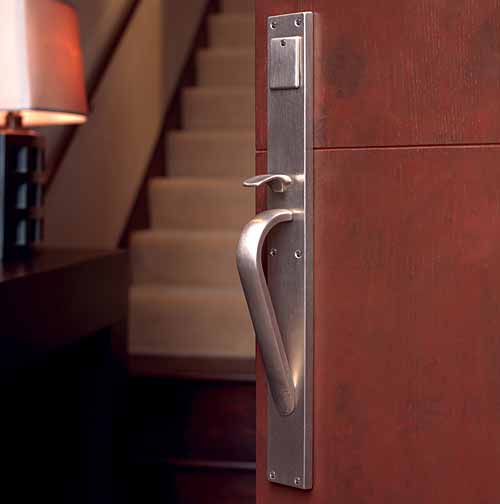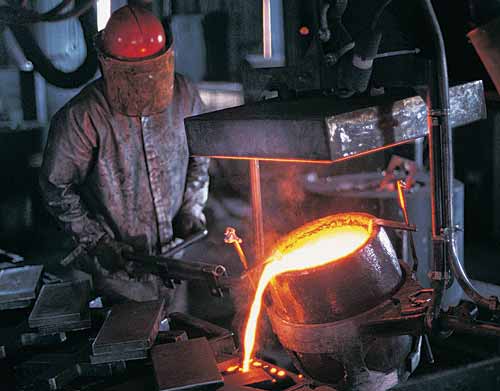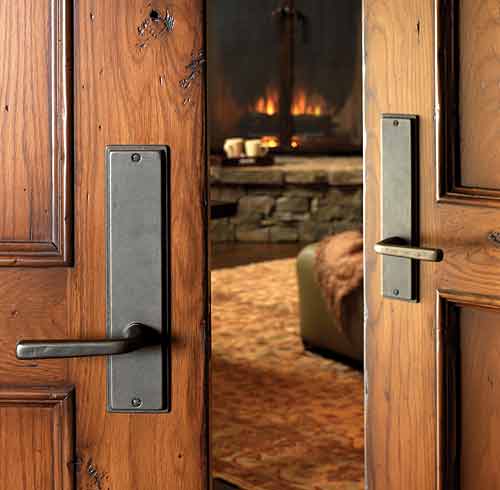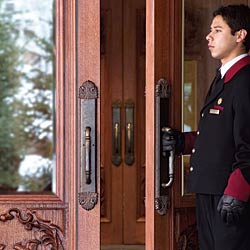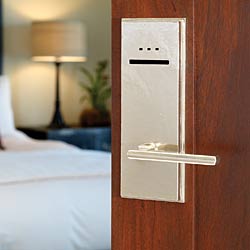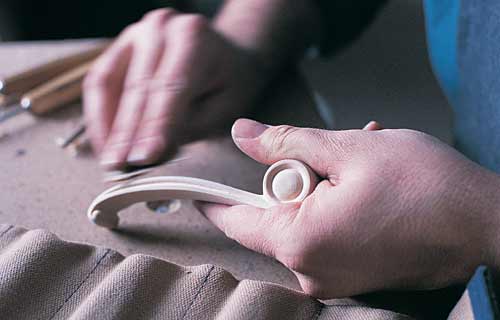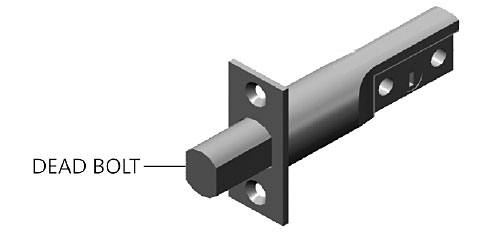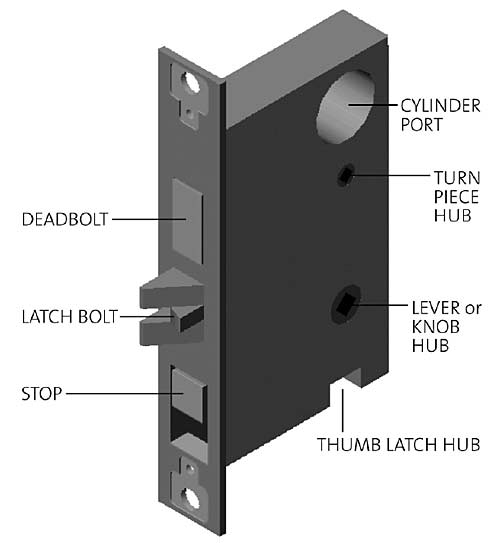Door Hardware Comes of Age
Distinctive Designs Meet Aesthetic and Security Requirements
![]() Continuing Education
Continuing Education
Use the following learning objectives to focus your study while reading this month’s Continuing Education article.
Learning Objectives - After reading this article, you will be able to:
- Discuss hardware trends.
- Identify appropriate design options, functions and mechanisms for hardware applications.
- Define the correct hardware for various door applications.
Door hardware is a critical element that provides passage, access, and security but whose operations we take for granted. The aesthetics of hardware design have strong influence on our perceptions of the space we are in or the building we are entering. The architect and designer's selection, application, and specification of door hardware will make a strong contribution to the project's success.
Hardware has evolved from crude, handmade attachments and closure pieces to machine-made, industrialized mechanisms of great precision and design distinctiveness. Most recently, there is a trend in high-end hardware toward distinctive design, which combines highlighting the natural properties of the brass or bronze from which hardware is cast, with its sculpture sense and precision-engineered properties. Hardware, which typically consumes approximately five percent of a building's construction budget, represents an annual construction value of $10 billion to $12 billion.
This article concentrates on high-end hardware for residential, commercial, and hospitality locations. It will familiarize you with the trends, the criteria, and the design decisions that enable the correct selection and specification of hardware for these locations.
|
Trends in Hardware
Hardware as a definer of residential design status has become a deeply entrenched value. Over the past 20 years, people have begun to devote more time and money to transforming their home into showplaces of their design and style. Propelled by this increasing demand, hardware manufacturers began producing door hardware and accessories to meet the needs of architects, designers, and sophisticated homeowners to complement the aesthetics of their design choices. Some manufacturers have responded by combining traditional techniques, such as investment (also known as lost wax casting), and sand casting, with state-of-the-art manufacturing equipment to produce the detail and quality of precisely engineered hardware with a traditional and natural look and feel.
The architectural style choices available today cover a broad spectrum, spanning from modern and post-modern to period, rustic, and traditional. Each style and design vocabulary requires details that work together to provide a harmonious appearance. Unlike the 19th century, when knobs were routine, lever handles have assumed greater prominence. Ease of use, adaptability to meet the Americans with Disabilities Act (ADA) requirements, and a sleek appearance are among the reasons contributing to their popularity.
More natural and organic products, like wood and stone, are being incorporated as major design elements into residential, commercial, and hospitality projects. Hardware, in turn, needs to reflect the natural properties of these materials. This design sympathy with natural products has trended hardware away from manufactured, finished appearances toward living finishes like bronze and patinas, which change naturally over time.
"Designers have embraced newer hybrid styles, such as ‘mountain modern' and ‘coastal contemporary'," notes Patsy Nickum, owner of Rocky Mountain Hardware. These styles combine the clean lines of modern design while integrating the warmth and character of organic materials and colors such as stone, wood, and structural steel. All are materials used in a raw state, were frequently covered with more finished materials, and now they are exposed and aged with time. Designers have begun to reflect the living and changing aspects of materials in their designs.
Increasingly, security hardware and devices are being adapted to many different applications. This high technology trend, combining traditional latch and lock mechanisms with IT systems, represents a design and coordination challenge for both architects and manufacturers.
Basic Issues Guiding Hardware & Selection Choices
Typically, the driving force behind selecting different hardware is based on the necessary function, and the basic distinction is between indoor and outdoor applications. Most exterior doors lock, and in many cases the doors are larger in scale (taller, wider, heavier, and carry more hardware) than interior doors. This is especially true of entry doors. In order to hold larger and sturdier locking mechanisms, such as a mortise lock, selecting doors with larger stiles, which provide more room for the trim, is fundamental to having more options in hardware selection. The mortise lock, which integrates the locking and latching mechanisms into a single cartridge style lock, is inset within the width of the door and is set within the stile, the vertical structural member of the door.
Many interior doors contain a locking mechanism, but these tend to be smaller than those that secure homes. This varies based on residential and commercial applications. Another broad assumption is that interior doors are not required to meet all of the stringent impact codes, especially relating to hurricanes and high wind conditions that exterior doors are often subject to. This also varies with application, particularly for interior doors in commercial and hospitality settings.
Intensity of Use
High-traffic areas demand lock mechanisms with high tolerance for use. If doors require locking mechanisms, mortise locks are generally recommended. Fewer working parts will assure better operation if it fits the need. For example, in a busy location, a push/pull device, instead of a lever or knob lockset, is preferable. This is typical for doors that do not require latches.
Low-use doors can employ many different mechanisms because the function will not be tested as much as on high use doors. Nevertheless, design professionals should determine the potential use and regulations of the door before specifying hardware. Available options depend on whether the door will be used primarily for security or passage.
Basic Materials
The most common metals used in hardware trim are brass, stainless steel, aluminum, and bronze. Selecting the proper hardware material for a project depends on aesthetics, durability, and availability in all necessary lock functions and sizes for the project.
Brass, which is most commonly drop or hot forged, has been popular for many years. This metal begins in a rod form, is heated until it is malleable, and is then pressed with extreme pressure into a mold. This technique forges a product free of blemishes or pockmarks. Brass is often highly polished and then lacquered as a protective coat. Sometimes manufactures plate brass to look like other finishes such as nickel then lacquer coat again for protection. These lacquered finishes, like anything that is touched and used on a regular basis, can crack, chip or peel, thus allowing the base metal to tarnish with time.
|
Forging tends to result in more highly finished, polished, blemish-free surfaces. Reverting to casting techniques yields finer detail products with a warm texture. Many products can be poured using the sand casting process but the lost wax process can be used to make products that have finer details, while still retaining the desired texture of casting.
Iron, which is still very common in Europe, is also a forged metal. If untreated, iron will bleed or rust, depending on the environment. In most cases, iron is powder coated to retard this natural occurrence. The black finish for which iron is often associated is popular for a rustic or barn-like appearance.
Stainless steel is typically a high-end, modern, or contemporary choice for door hardware. Like forged brass, it has a very smooth, clean-lined surface, and has been a popular material used by Italian- and German-based companies. This metal is often used in coastal environments, where salt-water air tarnishes most metals quickly. When selecting stainless-steel hardware, it is important to research products to be sure the lock mechanisms will not corrode. Not all stainless-steel hardware is appropriate for coastal conditions. Price typically dictates quality of finish.
Selecting & Specifying Hardware
Hardware choices and selections are governed by the function of the door, the style and type of hardware that most suitably meets the door's operating requirements, and both the appearance and the tacit signals the designer wishes to convey, such as push, pull and turn.
Hardware selection begins with lock functions. Important conditions and considerations include the following:
Entry. This refers to an exterior door with keyed access, which can be provided in single cylinder or double cylinder functions.
- Mortise Lock−Recommended for use with heavy or high-use doors Specific trim selections require this type of lock. It is an integrated lock (see Glossary). Technical attributes of a mortise lock include saw proof inserts in the deadbolts, push button locking capacity, and emergency egress function (single operation exit). Highly recommended for use with grip handle and thumb latch application.
- Deadbolts−Usually combined with a lever or knob function or a push/pull plate.
Patio. This is an exterior door that does not require key access, but requires lock function, and is typically used on doors that access a balcony or patio. The same lock choices as entries apply, mortise lock or deadbolt. In most cases, exterior doors have keyed access from the outside in, to overcome potential redundancy-of-locking situations. This occurs when several doors are in close proximity to each other or when external access is directed towards a single door.
Privacy. This function has three locking options, all with varying levels of security and use.
- Mortise lock−The most secure locking feature for high-use areas.
- Mortise bolt−Although this locking mechanism is not substantially stronger than the push-button locking spring latch, it offers a more identifiable locking feature. For example, this may be used for a bathroom door so that it is more obvious that the door is locked, as opposed to a push button mechanism.
- Spring latch (locking)−This is the most affordable locking mechanism. It is not necessarily weaker than the mortise bolt, but it is less obvious that the mechanism is actually locked.
Passage. This is a non-locking mechanism with operable handles. It is used on doors that do not need to be secured.
- Spring latch−This is a latch operated by a handle.
- Mortise lock box−While there is no locking capacity, it has the same mortise box as a locking mechanism, and functions as a latch.
Dummy. This refers to a set of inoperable handles on one or both sides of a door. This could also be the inoperable side of a double door condition. Dummies are often used with a roller catch or another latching mechanism.
Multi-point. Originally developed in Europe, this mechanism latches the doorframe in three or more places. Many American window companies have adopted this system.
Miscellaneous Functions:
- Corridor−This function allows the inside handles on both sides of the door to be open and functioning. One side has a locking turn piece or push button, such as a mortise lock or locking spring latch. This is typically used to lock an office or room that is not in a public area.
- Classroom−This function allows the inside handle to always be free while the outside handle can either be free or be lockable with a key via a mortise lock or a locking knob or lever. This restricts the locking function to the key holder.
- Store room−The inside handle is always open or free and the exterior handle is always locked. The locking mechanism is keyed from the exterior side.
- Hotel entry−Similar to the storeroom, except that there is an emergency egress deadbolt on the interior, allowing guests the ability to secure their room from the inside.
|
Doors.The size, construction, and proportion of doors are important factors when selecting hardware.
- Stile width−Choosing the width of the escutcheon, the back plate that attaches to the door, depends on the available surface, or stile width, while factoring in the overlap of the stop. These dimensions are critical. The goal is to fit the hardware on the door with an accommodation for ease of operation, thus allowing room to grab the lever or grip without hitting the knuckles. Matt Ostmann, Technical Director at Rocky Mountain Hardware observes, "A common problem that arises often is that the selected stile is too narrow to carry the standard escutcheon. Choosing a narrow stile may severely limit the designer's hardware options."
- Door Size−Typically, the height of the escutcheon is directly proportional to the door height. This is a subjective choice.
- Handing−This is the convention that indicates where the door is hinged and in what direction it swings. The diagram in the Glossary reflects the hardware industry standard. It is important to use the convention as illustrated when handing is specified.
- Backset−This defines the length from the edge of the door to the center of the lock. Standard lengths for tubular or spring latches are 2-3/8 inches and 2-3/4 inches. Standard lengths for mortise locks are 2-1/2 inches and 2-3/4 inches. These can have options for custom backsets but stile and hardware choices may limit the available options.
|
Design and Style Choices. This encompasses material, finish, and lever, and knob choices, as determined by the aforementioned criteria. Selecting the best hardware material that can function under varied climatic conditions, while maintaining basic design characteristics, has become increasingly challenging. Steel, stainless steel, and aluminum all have their applications, but none can combine resistance, durability, a natural aging process, and a natural appearance as well as bronze.
Bronze has several favorable properties when used for hardware. It is non-ferrous, neither powder-coated nor lacquered, and will not rust. Bronze interacts and ages well, working in coordination with time, touch, and climate. Over time, the material distinctly reflects its surroundings.
It ages naturally, but is quite durable and robust. Additionally, bronze can be tempered by various applied patinas, which can speed the aging process to create unique hues to complement any style.
Code Considerations
The American Society for Testing and Materials (ASTM) has a grading scheme for security ratings for doors and hardware (on a scale of 10 to 40) utilizing impact tests. These are becoming more prevalent in areas subject to hurricanes and high winds. Doors need to be engineered correctly to withstand most of these tests. The lock mechanism helps, but it cannot compensate for an inherent weakness in the door itself.
Some national codes, including ADA, are vague and are open to interpretation. For example, ADA 4.13.9 Door Hardware, governs the performance characteristics of door handles, and states "…handles, pulls, latches, locks, and other operating devices on accessible doors shall have a shape that is easy to grasp with one hand and does not require tight grasping, tight pinching, or twisting of the wrist to operate. Lever-operated mechanisms, push-type mechanisms, and U-shaped handles are acceptable designs. When sliding doors are fully open, operating hardware shall be exposed and usable from both sides…."
Increasingly, codes are driven by counties and municipalities, acting in response to local conditions. For example, Dade County in Southern Florida is a leader in drafting and mandating stricter hurricane and flood code provisions, many of which have been adopted in Florida, Gulf Coast states, and coastal states along the Atlantic seaboard. Much of Florida's building code provisions are influenced by "weather bands," based on historic studies within the state. Where wind forces are strongest, stricter codes prevail.
Insurance companies are also investing a significant amount of money and resources toward increasing the stringency and rigor of codes. The Texas Department of Insurance is among the most active. Design Pressure (DP) testing is also becoming an industry standard.
Handicapped Accessibility & Ergonomic Compliance
The Americans with Disabilities Act is the national legislation that demands specific handicapped accessibility standards be used in most buildings, whether they be public or private facilities. These requirements have been widely adopted. Individual states may have additional codes which overlay ADA. All of these codes reference door hardware. Therefore, design professionals must be familiar with the codes governing their projects.
For the elderly or disabled, selecting hardware that functions smoothly and with ease is an important consideration. This generally necessitates lever handles and minimum clearances between hardware and adjacent walls. Even in projects where ADA is not a governing factor, levers are typically a better option due to ease of use.
Heavy doors or areas with high winds and inclement weather are also best served by hardware that functions well based on conditions. This generally means that doors should open easily and without the need to apply excessive force. These doors are frequently equipped with automatic door openers.
Considerations in Selecting a Hardware Manufacturer
Selection of a hardware manufacturer with the ability and the technologies to implement the design is vital to a successful application. The manufacturer should offer a range of options in cohesive styles, materials, and design appearances, thus allowing the design professional to create the desired aesthetic look. The choices for lever, knob, escutcheon, patina, in various sizes to work with the size and scale of the project, contribute to an integrated end result.
Ideally, hardware manufacturers should possess custom capabilities, allowing each piece to be as individual as the spaces they complement and the people who design and use them. Design professionals should consider manufacturers with in-house engineering and design teams, capable of collaborating with architects to translate design ideas into aesthetic and functional spaces. Additionally, manufacturers offering other complementary accessories, such as hinges, doorstops, surface and cane bolts, doorknockers, and doorbell buttons, will simplify implementation of the design concept throughout the project.
|
Commercial & Hospitality Applications
High traffic, constant use, and security considerations are the main characteristics of commercial and hospitality hardware applications. Selecting the correct hardware in these areas is important in terms of safety and longevity of the hardware and doors. In areas such as train stations, ski lodges, country clubs, and office buildings, design professionals should choose hardware that is consistent with the durability required by the occupancy loads. The simpler the hardware is in operation, the more durable it will be. If a locking function is needed, doors may be secured using deadbolts, flush bolts, and surface bolts. The ability of the door and the hardware to accept security devices, such as card readers, is critical for these applications. Finishes are also important features. Metals that are powder coated or lacquered tend to peel, crack or scratch. Selecting a solid base metal, like bronze, will withstand use and naturally age with time.
In response to increased hurricane activity, coastal codes are becoming more stringent. It is important for design professionals to select hardware and door manufacturers who can meet all code demands without compromising design continuity.
Considerations for Specifying Hardware
Many factors come into play when selecting and specifying hardware. The following checklist will assist design professionals in determining the information needed to write the specification, and to enable manufacturers to provide all of the necessary components. This is a list of
features that will need to be pre-determined in order to write a thorough specification:
- Lock function and mechanisms (including mortise lock, dead bolt, and spring latch)
- Door thicknesses
- Backsets
- Handing
- Style (including interior/exterior escutcheon, interior/exterior handle)
- Finish
- Clear keying of doors on plans, elevations, and schedules that will allow the manufacturer and other related vendors to make accurate quantity take-offs by location and type of hardware set.
Differences between European and U.S. Practice
European and Asian hardware requirements vary from the U.S. However, most of the differences lie in the lock mechanism. Selecting a hardware manufacturer with advanced custom capabilities allows design professionals to specify the country-approved mechanism by
custom fitting trim. Depending on the country, mechanisms will be approved for use, and provide a comfort level for users. Building owners should be confident that their local locksmith could fix any problems.
As with hardware codes, European lock mechanisms cannot be grouped together. Country practices and regulations vary from one to the next, and sometimes this varies within borders. Each country and region uses a specific type of lock mechanism, commonly a profile cylinder or one using a bit key. Regardless, it is this mechanism that they are comfortable with and continue to use.
For example, many U.S. window and door manufacturers have adopted the "European Multi-Point" three-point locking system for their U.S. products. Matt Ostmann, Technical Director at Rocky Mountain Hardware, observes that, "For many users this has been, and continues to be, a difficult mechanism to adopt because it simply functions differently than a typical U.S. locking system. Lifting up on a lever handle to release the three locking points is not well understood or natural for Americans to conform to, even though it is a technically effective approach to opening and closure."
One system is not necessarily better than another, but depends upon what users are accustomed to. Therefore, any hardware manufacturer must go through a significant amount of research, trial, and error testing, before globalizing a product.
Conclusion
Design options for hardware have expanded dramatically in recent years. The complexity of hardware functions and technology has also been evolving to meet the conflicting requirements of the public and private realms. It is vitally important for architects and designers to remain aware of this basic area of design, and stay closely acquainted with what the hardware industry and hardware manufacturers are doing to meet these challenges.
|
Glossary of Terms
The following table defines critical hardware terms relating to lock functions, lock trim, lock mechanisms, and additionally related
functions, features, and practices.
LOCK FUNCTIONS:
Entry (Single Cylinder)
This is a locking set with operable handles that has a keyed cylinder on the exterior side of the door and a turn piece on the interior side (typically used on primary exterior doors).
Entry (Double Cylinder)
This is a locking set with operable handles that has a keyed cylinder on both sides of the door (typically used on primary exterior doors).
Dummy − Single
This is a set with an inoperable handle on one side of the door (typically in conjunction with roller catches, flush bolts or surface bolts).
Dummy − Full
This is a set with inoperable handles on both sides of the door (typically in conjunction with roller catches, flush bolts or surface bolts).
Passage
This is a non-locking set with operable handles (typically used on doors that do not require security or privacy such as closets, laundry or utility rooms, pantry, mechanical rooms and so on).
Patio
This is a locking set with operable handles that is locked by a turn piece from the interior side, but has no keyed access from the exterior (typically used on secondary exterior doors).
Privacy (Mortise Bolt or Mortise Lock)
This is a locking set with operable handles that is locked by a turn piece from the interior side and can be unlocked by an emergency release key from the exterior side (typically used on bedroom and
bathroom doors).
Privacy (Spring Latch)
This is a locking set with operable handles that is locked by a push button on the escutcheon from the interior side of the door and can be unlocked by an emergency release key from the exterior side (typically used on bedroom and bathroom doors).
Push / Pull
This is a set with inoperable grip handles and/or escutcheons. The set can have locking capacity in single cylinder, double cylinder or patio applications and is available in full or single dummy as well (typically used for commercial applications).
|
Escutcheon
Back plate that attaches to the door.
Handle
The portion of the set you grab to pull or rotate. The handle options are grips, levers, knobs or ring pulls.
Swing Cover
The flap that covers the cylinder or the emergency release access.
Thumb Piece
This piece retracts the latch bolt on a thumb latch entry lock set.
Turn Piece
This piece operates the dead bolt on the interior side of a locking set.
LOCK MECHANISMS:are the portion of the set operated by the handles, cylinders, thumb latches and turn pieces:
|
|
|
Multi-Point Lock Mechanisms
Mechanisms that latch the door at several points along the length of the door instead of a single point in close proximity to the handle. Multi-point locks are provided with the French doors made by most of the major window manufacturers. Due to the variety of multi-point sets available, it is recommended that a copy of the existing lock trim or a factory drawing be available so the trim can be machined correctly to match the lock in the door.
|
CYLINDERSare the portion of a lock where the key is inserted to lock or unlock the set. There are several different kinds common to entry sets:
Mortise Cylinders
Mechanisms that are threaded into mortise locks secured by a set screw through the edge of the lock and vary in length for different door thicknesses.
|
|
|
|
ADDITIONAL TERMINOLOGY:
Active Door
The primary door in a pair of doors and typically has an operable handle set.
Butt Hinges
Hinges with one leaf mortised to the jamb and one leaf mortised to the edge of the door.
Cabinet Roses
The back plates behind the cabinet knob or pull.
Clavos
Decorative nails typically applied to the surface of the door.
Edge Pulls
Used to retrieve a pocket door from the pocket.
Emergency Release
This term refers to the capability of a lock to be unlocked from the exterior side in case of an emergency situation. This is an aspect of most interior privacy lock sets.
Flush Pulls
Recessed pulls used on sliding doors such as pocket or bypass doors.
Handing
Indicates where the door is hinged and the direction it swings. Please see chart below.
 |
Inactive Door
The secondary door in a pair of doors. The inactive door is often secured with flush or surface bolts and typically has inoperable handles.
Ornamental Hinge Strap
A decorative piece of metal applied to the surface of the door to mimic a strap hinge.
Strap Hinges
Hinges that have one leaf applied to the surface of the jamb and one leaf attached to the surface of the door.
Spring Assist
Each handle has an additional spring attached to the handle and the escutcheon that returns the lever, knob or ring to the neutral position; this mechanism eliminates sagging handle.
|

